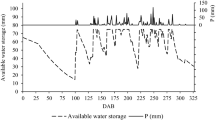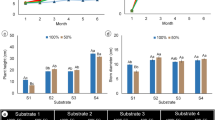Abstract
The objective of this study was to assess the physiological aspects of young green dwarf coconut cultivated in greenhouse as a function of soil class and different compaction levels and moisture conditions. The experiment was carried out in a greenhouse, using a randomized complete block design with nine replications and with 32 treatments in a 2 × 4 × 4 factorial scheme, with two soil classes—Typic Kandiudult and Umbric Dystrochrept, four compaction levels and four soil moisture conditions. Leaf predawn water potential (Ψw), net photosynthetic (A), stomatal conductance (gs), transpiration rates (E) and growth traits were higher in coconut grown in Umbric Dystrochrept soil. Moreover, these plants showed the highest values of maximum quantum yield of photosystem II (Fv/Fm) and leaf ‘greenness' (SPAD reading) was higher, but only in the lowest soil moisture condition, when compared with Typic Kandiudult. Higher soil moisture led to a higher Ψw for both soil classes. Close relationship between SPAD reading and the increase in soil moisture as well as between Fv/Fm and the increase in soil moisture for coconuts grown in Typic Kandiudult soil was observed. Furthermore, good correlations were observed between Ψw and the increase in soil moisture in coconuts grown in both soil classes as well as between Fv/Fm and the increase in soil density in coconuts grown in Typic Kandiudult soil. Effects of soil compaction were not observed on other physiological variables. Overall, green dwarf coconut trees grown in Umbric Dystrochrept soil allowed the higher water storage, which may contribute to increases in circumference, plant height, leaf area and dry weight (leaves, stem and root) linked to high photosynthetic rates.





Similar content being viewed by others
References
Araus JL, Hogan KP (1994) Comparative leaf structure and patterns of photoinhibition of the neotropical palms Scheelea zonensis and Socratea durissima growing in clearings and forest understory during the dry season in Panama. Am J Bot 81:726–738
Atwell BJ (1988) Physiological responses of lupin roots to soil compaction. Plant Soil 111:277–281
Bengough AG, Mullins CE (1990) Mechanical impedance to root growth: a review of experimental techniques and root growth responses. J Soil Sci 41:341–358
Beutler AN, Centurion JF (2004) Matéria seca e altura das plantas de soja e arroz em função do grau de compactação e do teor de água de dois latossolos. Eng Agric 24:142–149
Bolhar-Nordenkampf HR, Long SP, Baker NR, Oquist G, Schreibers U, Lecher EG (1989) Chlorophyll fluorescence as a probe of the photosynthetic competence of leaves in the field: a review of current instrumentation. Funct Ecol 3:497–514
Campostrini E, Yamanishi OK (2001) Influence of mechanical root restriction on gas-exchange of four papaya genotypes. Braz J Plant Physiol 13:129–138
Carr MKV (2011) The water relations and irrigation requirements of coconut (Cocos nucifera): a review. Exp Agric 47:27–51
Chaves MM, Maroco JP, Pereira JS (2003) Understanding plant responses to drought from genes to the whole plant. Funct Plant Biol 30:239–264
Chaves MM, Flexas J, Pinheiro C (2009) Photosynthesis under drought and salt stress: regulation mechanisms from whole plant to cell. Ann Bot 103:551–560
DaMatta FM (1999) Mecanismos fisiológicos associados ao desenvolvimento do sistema radicular das plantas. Anais Workshop sobre Sistema Radicular: Metodologias e Estudo de Casos. Embrapa Tabuleiros Costeiros, Aracaju, SE
DaMatta FM, Rena AB (2001) Tolerância do café à seca. In: Zambolin L (ed) Tecnologia de produção de café com qualidade. Universidade Federal de Viçosa, Viçosa, pp 65–100
Davies WJ, Zhang J (2001) Root signals and the regulation of growth and development of plants in drying soil. Annu Rev Plant Physiol 42:55–76
Dias Júnior MS (2000) Compactação do solo. In: Novais RF, Alvarez Venegas VH, Schaefer CEGR (eds) Tópicos em ciência do solo. Sociedade Brasileira de Ciência do Solo, Viçosa, pp 55–94
Donovan LA, Linton MJ, Richards JH (2001) Predawn plant water potential does not necessarily equilibrate with soil water potential under well-watered conditions. Oecologia 129:328–335
Evans JR (1989) Photosynthesis and nitrogen relationship in leaves of C3 plants. Oecologia 78:9–19
Farooq M, Wahid A, Kobayashi N, Fujita D, Basra SMA (2009) Plant drought stress: effects, mechanisms and management. Agron Sustain Dev 29:185–212
Flexas J, Bota J, Loreto F, Cornic G, Sharkey TD (2004) Diffusive and metabolic limitations to photosynthesis under drought and salinity in C3 plants. Plant Biol 6:269–279
Flexas J, Diaz-Espejo A, Galmes J, Kaldenhoff R, Medrano H, Ribas-Carbo M (2007) Rapid variations of mesophyll conductance in response to changes in CO2 concentration around leaves. Plant Cell Environ 30:1284–1298
Franks PT, Drake PL, Froend RH (2007) Anisohydric but isohydrodynamic: seasonally constant plant water potential gradient explained by a stomatal control mechanism incorporating variable plant hydraulic conductance. Plant Cell Environ 30:19–30
Gomes FP, Prado CHBA (2010) Coconut palm: ecophysiology under water deficit conditions. In: DaMatta F (ed) Ecophysiology of tropical tree crops. Nova Science Publishers, New York, pp 151–179
Gomes FP, Oliva MA, Mielke MS, Almeida AF, Leite HG, Aquino LA (2008) Photosynthetic limitations in leaves of young Brazilian green dwarf coconut (Cocos nucifera L. “nana”) palm under well-watered conditions or recovering from drought stress. Environ Exp Bot 62:195–204
Gregory P (2006) Plant roots: growth, activity and interaction with soils. Blackwell, Oxford
Hartung W, Zhang J, Davies WJ (1994) Does abscisic acid play a stress physiological role in maize plants growing in heavily compacted soil? J Exp Bot 45:221–226
Hussain A, Black CR, Taylor IB, Roberts JA (1999) Soil compaction. A role for ethylene in regulating leaf expansion and shoot growth in tomato. Plant Physiol 121:227–1237
Jones HG (1992) Plants and microclimate. A quantitative approach to environmental plant physiology, 2nd edn. Cambridge University Press, Cambridge
Kozlowski TT (1999) Soil compaction and growth of woody plants. Scand J For Res 14:596–619
Lambers H, Chapin FS III, Pons TL (2008) Plant physiological ecology. Springer, New York
Lawlor D, Cornic G (2002) Photosynthetic carbon assimilation and associated metabolism in relation to water deficits in higher plants. Plant Cell Environ 25:275–294
Ling Q, Huang W, Jarvis P (2011) Use of SPAD-502 meter to measure leaf chlorophyll concentration in Arabidopsis thaliana. Photosynth Res 107:209–214
Masle J (1990) Growth and stomatal behavior: responses to soil resistance to root penetration. In: Davies WJ, Jeffcoat B (eds) Importance of root to shoot communication in responses to environmental stress. University of Lancaster Press, Lancaster, pp 95–113
Masle J (1998) Growth and stomatal responses of wheat seedlings to spatial and temporal variations in soil strength of bi-layered soils. J Exp Bot 49:1245–1257
Passos CD, Passos EEM, Prado, CHBA (2005) Comportamento sazonal do potencial hídrico e das trocas gasosas de quatro variedades de coqueiro anão. Boletim de Pesquisa e Desenvolvimento. N.18, Embrapa Tabuleiros Costeiros, Aracaju
Prado CHBA, Passos EEM, Moraes JAPV (2001) Photosynthesis and water relations of six tall genotypes of Cocos nucifera in wet and dry seasons. S Afr J Bot 67:169–176
Schölander PF, Hammel HT, Hemingsen EA, Bradstreet ED (1965) Hydrostatic pressure and osmotic potentials in leaves of mangroves and some other plants. Proc Natl Acad Sci USA 51:119–125
Sheriff DW, Nambiar EKS (1995) Effect of subsoil compaction and three densities of simulated root channels in the subsoil on growth, carbon gain and water uptake of Pinus radiate. Aust J Plant Physiol 22:1001–1013
Silva VR, Reinert DJ, Reichert JM (2000) Soil strength as affected by combine wheel traffic and two soil tillage systems. Cienc Rural 30:780–795
Sobral LF (1998) Nutrição e Adubação do coqueiro. In: Ferreira JMS, Warwick DRN, Siqueira LA (eds) A Cultura do coqueiro no Brasil. Embrapa Tabuleiros Costeiros, Aracaju, pp 129–157
Stacanti G, Nogueira JB, Vilar OM (1981) Compactação do solo. Ensaios de laboratório em mecânica do solo 7. Universidade de São Paulo, São Paulo, pp 81–93
Tardieu F, Zhang J, Katerji N, Bethonod O, Davies WJ (1994) Xylem ABA controls the stomatal conductance of field-grown maize subjected to soil compaction or soil drying. Plant Cell Environ 15:193–197
Torres Netto A, Campostrini E, Oliveira JG, Yamanishi OK (2002) Portable chlorophyll meter for the quantification of photosynthetic pigments, nitrogen and the possible use for assessment of the photochemical process in Carica papaya L. Braz J Plant Physiol 14:203–210
Torres Netto A, Campostrini E, Oliveira JG, Bressan-Smith RE (2005) Photosynthetic pigments, nitrogen, chlorophyll a fluorescence and SPAD-502 readings in coffee leaves. Sci Hort 104:199–209
Tschaplinski TJ, Blake TJ (1985) Effects of root restriction on growth correlations, water relations and senescence of alder seedlings. Physiol Plantarum 64:167–176
Valicheski RR, Marciano CR, Peçanha AL, Bernardes RS, Monnerat PH (2011) Estado nutricional do coqueiro cultivado em solos submetidos a diferentes níveis de compactação e umidade. Rev Bras Eng Agric Amb 15:1152–1160
Waraich EA, Ahmad R, Halim A, Aziz T (2012) Alleviation of temperature stress by nutrient management in crop plants: a review. J Soil Sci Plant Nutr 12:221–244
Yoder BJ, Pettigrew-Crosby RE (1995) Predicting nitrogen and chlorophyll content and concentrations from reflectance spectra (400–2500 nm) at leaf and canopy scales. R Sens Envir 53:199–211
Acknowledgements
The authors thank the Horto Municipal de Quissamã, RJ, Brazil, for the coconut tree, CAPES for the research grant and FAPERJ for funding the project (Proc. No. E-26/171.618/2001) and grant to W.P. Rodrigues (E-26/202.323/2017). The authors thank CNPq for the fellowships awarded to E. Campostrini. We are also thankful to Dr. Maria Manuela Chaves Dep. Botânica e Engenharia Biológica. Instituto Superior de Agronomia (ISA), Lisbon, Portugal, for the helpful discussions and grammar correction.
Author information
Authors and Affiliations
Contributions
ALP, CRM and EC were involved in study concept and management.ALP, CRM, EC, RRV, RSB and AT-N conducted the experiments. ALP, CRM, EC, RRV and WPR analyzed and interpreted the data. ALP, CRM, EC, RRV and WPR wrote the manuscript. ALP, CRM, EC, RRV and WPR reviewed the manuscript at the final version.
Corresponding author
Rights and permissions
About this article
Cite this article
Peçanha, A.L., Marciano, C.R., Rodrigues, W.P. et al. Soil Class, Mechanical Impedance and Irrigation: Impact on Physiological Performance in Green Dwarf Coconut. Agric Res 8, 92–101 (2019). https://doi.org/10.1007/s40003-018-0356-0
Received:
Accepted:
Published:
Issue Date:
DOI: https://doi.org/10.1007/s40003-018-0356-0




